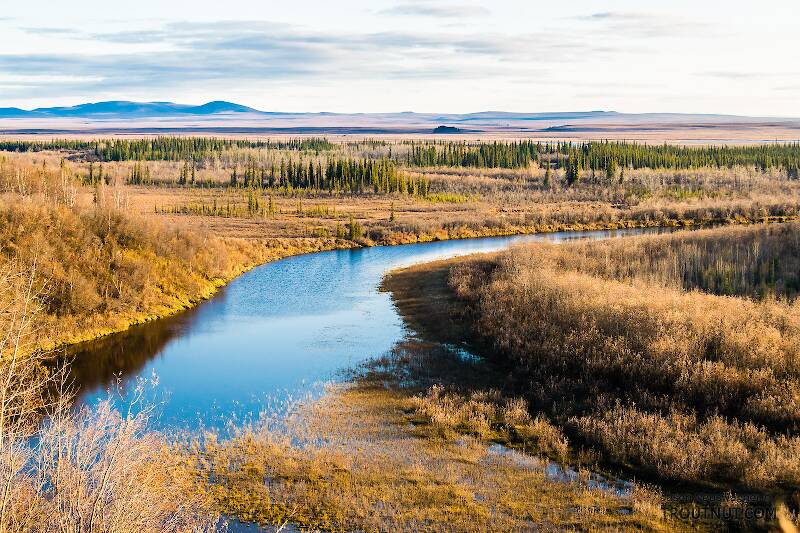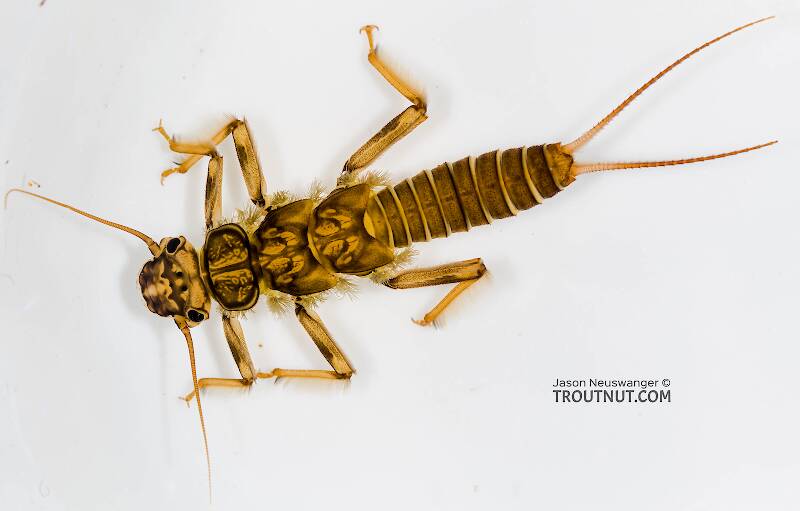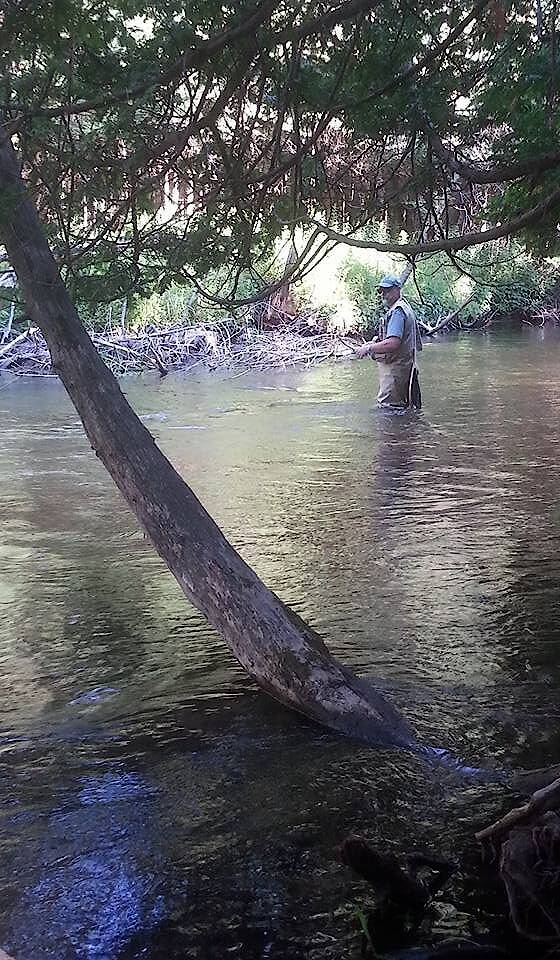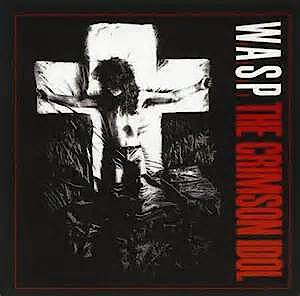
Hex Mayflies
Hexagenia limbata
The famous nocturnal Hex hatch of the Midwest (and a few other lucky locations) stirs to the surface mythically large brown trout that only touch streamers for the rest of the year.
Featured on the forum

Troutnut is a project started in 2003 by salmonid ecologist Jason "Troutnut" Neuswanger to help anglers and
fly tyers unabashedly embrace the entomological side of the sport. Learn more about Troutnut or
support the project for an enhanced experience here.
Roguerat on Jul 10, 2012July 10th, 2012, 3:24 pm EDT
Has anyone used the so-called 'lead-head' weighted leader inserts that are spliced into leaders to make them sink? I'm somewhat fiscally-challenged this summer (orthodontist bills; no offense to those in this profession but braces are $$$$$$...) and ran across these in various catalogs, wondering if they really work as advertised or intended...vs. investing in sink-tip flylines.
Cortland has a few kits on the market, and I thought Gudebrod had some as well.
Tight lines to all, and catch one for me- I had zip success last week due to warm water temps (have to blame something!).
The Roguerat
I Peter 5:7 'Cast your cares upon Him...'
Cortland has a few kits on the market, and I thought Gudebrod had some as well.
Tight lines to all, and catch one for me- I had zip success last week due to warm water temps (have to blame something!).
The Roguerat
I Peter 5:7 'Cast your cares upon Him...'
Adirman on Jul 12, 2012July 12th, 2012, 3:10 am EDT
What is stack mending Bman? Can you describe it?
Thanks,
Adirman
Thanks,
Adirman
PaulRoberts on Jul 13, 2012July 13th, 2012, 7:50 am EDT
I make my own from leadcore trolling line. I had an article in American Angler about them. Putting the weight in the leader, vs on the end of the fly-line has numerous advantages. They're easy to make and I carry several lengths (30" to 52") in a wallet.
To make some:
Use 45# leadcore trolling line as it has more lead per unit length than the lighter ones. You can purchase a lifetime supply for you and your buddies from one spool of leadcore, or mooch a few yards from someone who already has some. The stuff comes "color-coded" for depth measuring and I use an indelible marker to knock down the brightness of some sections.
For the butt end, pinch off a few inches of lead (by sliding down the casing) and then tie a Surgeon's Loop in the now lead-less braided casing. At the tippet end keep the lead inside and attach a short (2-1/2 to 3ft) two part tippet with a nail knot (say, .011 and .009 or what have you).
Loop-to-loop the leadcore head to your leader butt. You can use them on an existing multi-purpose outfit or, as I do, dedicate a reel spool to it bc fishing such a leader off a good floating line will beat the line up. I've used full sinks and floaters but for most stream work a floating line has many advantages in casting and line handling.
My "leadcore" set-up uses a cheap 6wt level floater with 4ft of .015 Maxima for the leader butt. Since you are "Oval Casting"/chucking the weight the normal function of a heavy tapered leader butt is lost. The .015 butt is stronger than my tippets but thin enough to allow the leadcore to sink.
These weighted leaders cast very nicely once you get used to keeping an open loop using an "Oval Cast". They don't hang up much and with the floating line you can mend to the sunken leader beautifully. Fish hook themselves against the weight of the rig and tension of water on the leader and line. Keep the rod tip up (~45deg) and let the fish hook themselves. I don't foul fish fishing this way, owing I believe to the short tippet (as well as giving a damn).
To make some:
Use 45# leadcore trolling line as it has more lead per unit length than the lighter ones. You can purchase a lifetime supply for you and your buddies from one spool of leadcore, or mooch a few yards from someone who already has some. The stuff comes "color-coded" for depth measuring and I use an indelible marker to knock down the brightness of some sections.
For the butt end, pinch off a few inches of lead (by sliding down the casing) and then tie a Surgeon's Loop in the now lead-less braided casing. At the tippet end keep the lead inside and attach a short (2-1/2 to 3ft) two part tippet with a nail knot (say, .011 and .009 or what have you).
Loop-to-loop the leadcore head to your leader butt. You can use them on an existing multi-purpose outfit or, as I do, dedicate a reel spool to it bc fishing such a leader off a good floating line will beat the line up. I've used full sinks and floaters but for most stream work a floating line has many advantages in casting and line handling.
My "leadcore" set-up uses a cheap 6wt level floater with 4ft of .015 Maxima for the leader butt. Since you are "Oval Casting"/chucking the weight the normal function of a heavy tapered leader butt is lost. The .015 butt is stronger than my tippets but thin enough to allow the leadcore to sink.
These weighted leaders cast very nicely once you get used to keeping an open loop using an "Oval Cast". They don't hang up much and with the floating line you can mend to the sunken leader beautifully. Fish hook themselves against the weight of the rig and tension of water on the leader and line. Keep the rod tip up (~45deg) and let the fish hook themselves. I don't foul fish fishing this way, owing I believe to the short tippet (as well as giving a damn).
PaulRoberts on Jul 13, 2012July 13th, 2012, 10:29 am EDT
Hmmmm... good question. I would guess so, although there may be alternatives now. It would have to be dense stuff though.
Martinlf on Jul 13, 2012July 13th, 2012, 11:55 am EDT
Paul, What year and issue of AA? I bought some leadcore trolling line years back, based on an article I had read (yours?), then could never locate the article again. At that time I was keeping a pretty extensive index to my fishing magazines on my computer, but repeated searches failed to get me back to the article--and I think it never got into the index. I'd like to see the circle close on this one, as I spent a good bit of time then and never could find it.
Do you use this kind of leader for nymphs primarily? Might it work for wet flies? I'm looking to fish wets a bit from time to time, and a local guide who specializes in wet flies uses a sink tip line. I'd rather put something together for now just to play with than invest in a new line. I have some old fly lines that I could use for now.
Of course, if I go this route, I'll have to dig up the trolling line, and if it's not where I think it is, I could burn another day looking for it! ;>
Do you use this kind of leader for nymphs primarily? Might it work for wet flies? I'm looking to fish wets a bit from time to time, and a local guide who specializes in wet flies uses a sink tip line. I'd rather put something together for now just to play with than invest in a new line. I have some old fly lines that I could use for now.
Of course, if I go this route, I'll have to dig up the trolling line, and if it's not where I think it is, I could burn another day looking for it! ;>
"He spread them a yard and a half. 'And every one that got away is this big.'"
--Fred Chappell
--Fred Chappell
PaulRoberts on Jul 13, 2012July 13th, 2012, 1:28 pm EDT
Hi Louis,
It was in the Jan/Feb 2003 issue.
It would be great for wets, beating an integral sink-tip hands down in several important ways. Essentially, separating the line and the weight are important bc they have very different functions. The LC leader is the fishing end and should be below surface currents, while the line is for getting that weighted rig where it needs to go, and then manipulating it. The line should be above the surface currents. Mending a floating line to a sunken leader is a joy.
I used mine primarily for big lake-run salmonids with both streamers and wets, both of which were #8 or larger, usually on a 6wt rod. LC leaders were so effective and fun to fish and mend to, that I also used them for resident trout in (as Brookyman mentions) streams med sized and up, esp in spring when flows were up. So I guess I used it in colder seasons. Summer water is less viscous and trout are more active. After summer showers, when levels came up, and trout left the wood work, they were active enough that they’d move for flies and I never broke out the LC.
When I used LC I swung streamers, wets, and sculpins through tailouts, or deep under undercuts and wood. Getting the fly down just an extra foot or two, and keeping it there, can do wonders. Man, just writing this I can actually feel big browns and steelies just CRACKING that streamer as it was held or slowly swum deep under a jam. RRRRIIIIIPPPPpppppp!!! If the fish is big enough, the line sings.
For lighter flows and/or smaller water, a weighted fly or shot tends to be adequate. I'd say LC is for places where fish are under, or unwilling to come up into, the heavier ceiling currents. It also works well for keeping the fly down on across current retrieves, which trout (and other fish) can find irresistible. I found 36 to 48inch sections most applicable. Shorter lighter heads were not much different than weighted flies.
I do not know what lighter (say 27 or 18lb) LC would do on lighter rods with smaller hooks. Worth experimenting I suppose. But I seem to remember coming to the conclusion that water is water (density wise –at trout temps) and you need some weight to cut it. So in my article I say skip the light stuff. In winter when water is cold and viscous, you’ll need 4ft of 45lb LC to get anywhere.
Nymphs? Some of the "wets" were buggy Flymph type deals that could be fished nymph-like. The lines across subsurface presentations can certainly blur. Leadcore spliced into leaders really shines for downstream or across stream presentations, although I did catch fish by throwing up and then throwing slack to control speed. There are more effective rigs for upstream I think though.
It was in the Jan/Feb 2003 issue.
It would be great for wets, beating an integral sink-tip hands down in several important ways. Essentially, separating the line and the weight are important bc they have very different functions. The LC leader is the fishing end and should be below surface currents, while the line is for getting that weighted rig where it needs to go, and then manipulating it. The line should be above the surface currents. Mending a floating line to a sunken leader is a joy.
I used mine primarily for big lake-run salmonids with both streamers and wets, both of which were #8 or larger, usually on a 6wt rod. LC leaders were so effective and fun to fish and mend to, that I also used them for resident trout in (as Brookyman mentions) streams med sized and up, esp in spring when flows were up. So I guess I used it in colder seasons. Summer water is less viscous and trout are more active. After summer showers, when levels came up, and trout left the wood work, they were active enough that they’d move for flies and I never broke out the LC.
When I used LC I swung streamers, wets, and sculpins through tailouts, or deep under undercuts and wood. Getting the fly down just an extra foot or two, and keeping it there, can do wonders. Man, just writing this I can actually feel big browns and steelies just CRACKING that streamer as it was held or slowly swum deep under a jam. RRRRIIIIIPPPPpppppp!!! If the fish is big enough, the line sings.
For lighter flows and/or smaller water, a weighted fly or shot tends to be adequate. I'd say LC is for places where fish are under, or unwilling to come up into, the heavier ceiling currents. It also works well for keeping the fly down on across current retrieves, which trout (and other fish) can find irresistible. I found 36 to 48inch sections most applicable. Shorter lighter heads were not much different than weighted flies.
I do not know what lighter (say 27 or 18lb) LC would do on lighter rods with smaller hooks. Worth experimenting I suppose. But I seem to remember coming to the conclusion that water is water (density wise –at trout temps) and you need some weight to cut it. So in my article I say skip the light stuff. In winter when water is cold and viscous, you’ll need 4ft of 45lb LC to get anywhere.
Nymphs? Some of the "wets" were buggy Flymph type deals that could be fished nymph-like. The lines across subsurface presentations can certainly blur. Leadcore spliced into leaders really shines for downstream or across stream presentations, although I did catch fish by throwing up and then throwing slack to control speed. There are more effective rigs for upstream I think though.
Martinlf on Jul 13, 2012July 13th, 2012, 5:30 pm EDT
Paul, it was your article! Small world! And, predictably, the LC is AWOL at this point. But I have a few other places to look when I gain the will to dig into them.
"He spread them a yard and a half. 'And every one that got away is this big.'"
--Fred Chappell
--Fred Chappell
Quick Reply
Related Discussions
Topic
Replies
Last Reply






